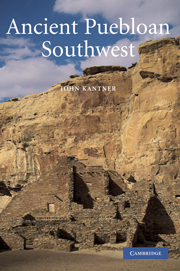Book contents
- Frontmatter
- Contents
- List of figures
- List of boxes
- Acknowledgments
- 1 The ancient Puebloan Southwest: an introduction
- 2 “The Daylight World”: the paleoenvironmental context for Puebloan history
- 3 Return to Ánosin Téhuli? The origins of Puebloan culture
- 4 The wrong Middle Places? Chaco Canyon and the Mimbres Mogollon
- 5 The migrations continue: the end of Chaco and Mimbres
- 6 The AD 1200s: the Great Pueblo period
- 7 The Great Abandonment
- 8 Finding Posi: the protohistoric Puebloan world
- References
- Index
6 - The AD 1200s: the Great Pueblo period
Published online by Cambridge University Press: 05 February 2015
- Frontmatter
- Contents
- List of figures
- List of boxes
- Acknowledgments
- 1 The ancient Puebloan Southwest: an introduction
- 2 “The Daylight World”: the paleoenvironmental context for Puebloan history
- 3 Return to Ánosin Téhuli? The origins of Puebloan culture
- 4 The wrong Middle Places? Chaco Canyon and the Mimbres Mogollon
- 5 The migrations continue: the end of Chaco and Mimbres
- 6 The AD 1200s: the Great Pueblo period
- 7 The Great Abandonment
- 8 Finding Posi: the protohistoric Puebloan world
- References
- Index
Summary
During the journey of the clans in search of the Middle Place, the ancestral Zuni came upon the Kianakwe people who lived in large towns in the highlands and cliffs. As related in oral traditions, the inhabitants of these places were successful farmers who could command the waters to their fields without the need for rain, and they had many possessions. And so the ancients, the Áshiwi, hungry from long wandering, attacked. But aided by Kúyapalitsa the deathless Ancient Warrior Woman, the enemy could not be defeated. Rain fell, stretching the sinew of the Áshiwi bows, and many were captured. By evening of the third day, the Kianakwe had captured four Áshiwi gods, and prospects for success were dim. Then it was learned that Kúyapalitsa carried her heart in her rattle, and the Áshiwi devised new bows of yucca fibers that were impervious to rain. So on the fourth day, Kúyapalitsa was slain, the town taken, and the Áshiwi captives freed. The surviving Kianakwe were spared owing to the knowledge they could provide. “Thereby our fathers gained much knowledge, even of their own powers and possessions … Growing wiser in the ways of living, they learned to cherish their corn more, discovering they might have life and abundance rather than cause death and hunger” (Wright 1988:90–1).
The Great Pueblos of the north
As the AD 1200s began, the Puebloan Southwest was experiencing a remarkable transition as the reverberations of Chaco's and Mimbres's disintegration continued to be felt and people moved toward new forms of organization.
- Type
- Chapter
- Information
- Ancient Puebloan Southwest , pp. 159 - 194Publisher: Cambridge University PressPrint publication year: 2004



